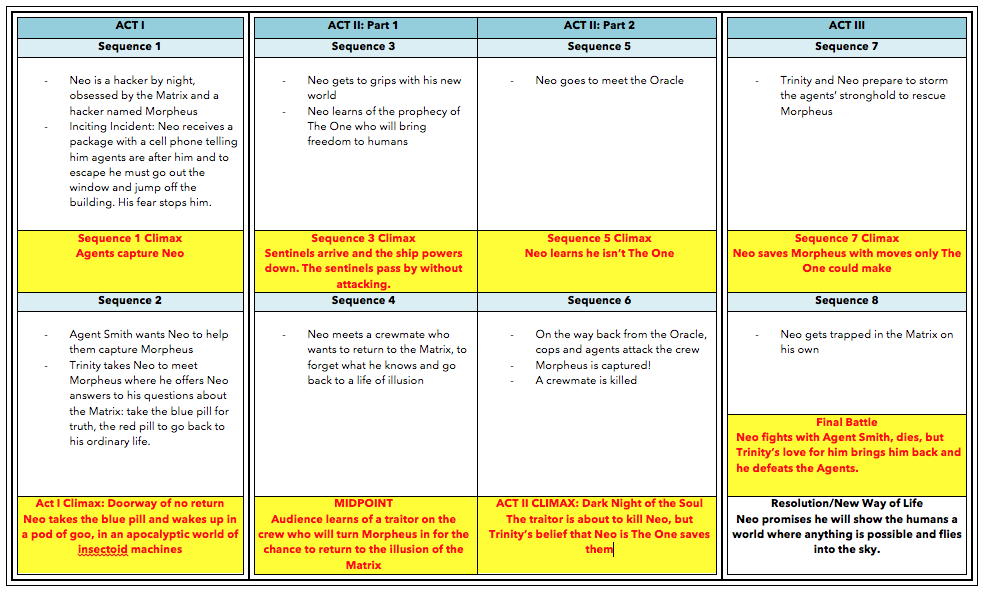Yup. You read right. I'm going to attempt to not only stay awake for 24 hours (no mean feat for someone who is usually in bed by 9:30 pm), but also write! Fear not. I am armed with a plan to defeat sleepy gibberish: massive amounts of coffee, and a plot outline! Now I know lots of pantsers are going to groan at this. I too started out as a panster, but after the mind twisting effort required to deconconstruct my first novel so that I could revise and edit it properly, I've been well and truly converted. I've found a happy medium between being a structure plotter and a detail pantser.
I've frankensteined various techniques and advice into a fast-track outline for my Nanowrimo plan, and I'm going to rely on it heavily during the Scrivathon so I can concentrate on writing, not figuring out where the story is headed. My secret weapon is a three act eight sequence structure, one most of you will be very familiar with since Hollywood movies tend to closely follow this format. If you want to delve deep, Alexandra Sokoloff's Stealing Hollywood is a great primer.
In a nutshell, here are the three acts of a story: Act I: Get hero up tree. Act II: Throw rocks at him. Act III: Get him down. Bang. Easy as pie Movies take these three acts and break them down even further into eight sequences. These eight sequences originate from the early days of film when movies were divided into reels. Eight reels of ten to fifteen minutes of film per movie. Every reel had to be changed, so, as you can imagine, the story was constantly being interrupted.
The trick to keeping your audience from getting irritated and walking out was to keep them so invested in the story they had to know what happened next. How do you this? one word: Cliffhangers. Moviemakers ensured there was a climax at the end of every reel that built towards a single question: what's going to happen now? The release of that tension—the answer to the question—came after the reel change. An evil but brilliant ploy that translates beautifully into novels.
Below are the three acts overlaid into an eight sequence structure (click to embiggen). You'll see Act 1 and Act 3 are approximately 25% of the story each, while Act 2 is 50% of the story. Sometimes people just call this a four act structure. It doesn't really matter what you call it, since the shape of it stays the same. However you call it, you'll see at the end of every sequences is a climax--the "oh no!" scene that keeps the reader glued to your pages. The bigger climaxes come at the end of the Acts and at the midpoint.
Taking The Matrix as an example, here is The Matrix in three acts: Act 1: Neo, a hacker by night and office drone by day, wakes up naked and bald in a cocoon tank of goo. His entire life was a dream, and a post-apocalyptic world where humans are energy sources for machines is the new reality. The story question: Is he The One? Act 2: Neo learns the truth of the Matrix and the machines that control their world. He joins the resistance fighting them. His friends are attacked, some die. He learns he isn't The One. Act 3: Neo digs deep, and becomes The One. There is hope for humans again. Very simplistic. But you get Neo in the tree, chuck rocks at him (both physically and also spiritually as his belief in himself is tested), and then he figures out how to get himself out of the tree. Now here is Matrix again sketched out in the 8 Sequence Chart. Bear in mind that some stories have more sequences and some have less. The beauty is that the structure will stretch and compress to suit your story.
So this is my secret weapon that will carry me through Nanowrimo and Scrivathon. I'll break down some of the more complex sequences into scenes for my own sanity, but over all I like the freedom a loose outline gives me. If you'd like to join me in a 24 hour writing caper, read on!
About Scrivathon

Scrivathon takes place on 12 November for 24 hours. It doesn't matter when you start, so long as you start sometime on the 12 November, and count 24 hours from there. Anyone can join. All it takes is your imagination, something to write with, and time.
Participants and observers can help fundraise for our chosen charity—Syria Relief—either by donating, entering our raffle draws, or encouraging friends and family to pledge donations for word count and/or writing hours. A little bit about our chosen charity: we held a poll for charities to support, and the overwhelming choice was Syria Relief, a UK registered charity that provides humanitarian aid to those affected by the Syrian crisis.
While the majority of international aid only reaches the borders of Syria, Syria Relief is unique in that it works in the heart of Syria, often in besieged areas like Aleppo. Every dollar raised supports Syria Relief in their provision of medical aid, emergency surgery, education, water & sanitation, food, orphan support, blankets, shelter, and heaters where the need is most urgent. For more information on Syria Relief and their amazing work, click here: www.syriarelief.org.uk.
Thanks to our generous sponsors, Scrivathon has a whole list of amazing raffle prizes. Do you need an editor to help polish your manuscript? Or professional eyes on your query or first pages? We have everything from book coaches to freelance editors to a literary agent offering valuable expertise to hone your work. Do you need writing software? We have Scrivener and Save the Cat! downloads up for grabs. Books? All it takes for a chance to win is a simple donation to Syria Relief. There is no minimum. Even $5 would be greatly appreciated.
You choose how much to donate for each raffle entry. You can donate as many times as you want. Anyone can enter the raffle draws—whether you word sprint with Scrivathon or not. Don't miss out. Follow the links and instructions here to enter. If you'd like to join here's a mini how-to:
- Create your fundraising page with Justgiving.com. Easy step by step instructions here.
- Fundraise by getting family and friends to sponsor you. There is no minimum donation required, every penny helps. Get creative. Suggest they sponsor by the word, by the hour, or an easy fixed amount.
- Find & encourage fellow Scrivathoners on twitter using #Scrivathon16 and in the #Scrivathon16 Facebook group.
- Thunder the Scrivathon event by joining our online flashmob here.
Bio

A.Y. Chao is a recovering lawyer and expat Canuck who lives in London England. When not organising Scrivathon, she writes urban fantasy, edits, and teaches. Her first novel Soul Affinity won the 2016 RWA Indiana Golden Opportunity contest. You can find her on Twitter @ay_chao, on Facebook at A.Y. Chao Author, or her website aychao.com.



Great post, Alice. Nice explanation of your panster/plotter process. I'm in awe of your efforts for such a noble cause. Happy to be a part of it.
ReplyDeleteDoing NaNoWriMo, too, but a variance on it: two novellas, same total word count.
ReplyDeleteEnjoy.